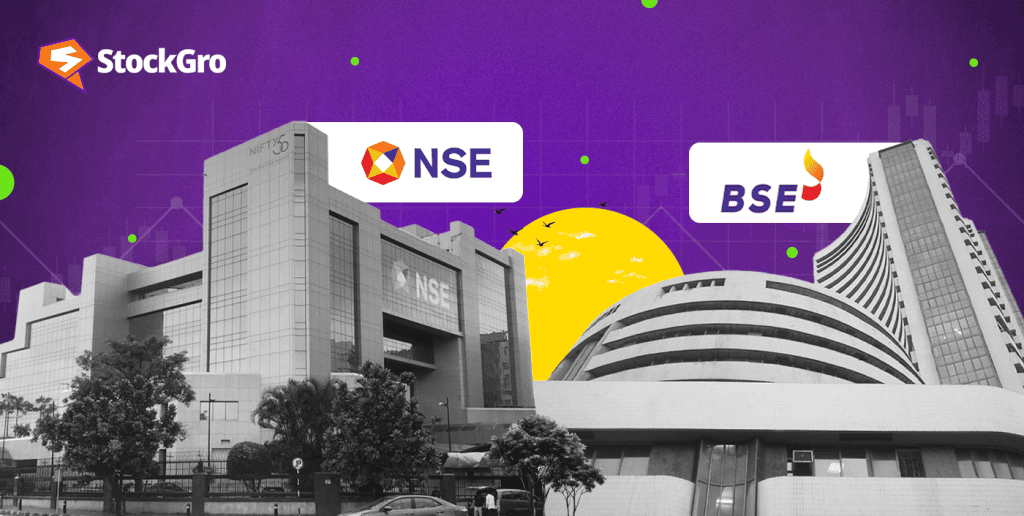
Beginners in the stock markets often get confused when they learn about the National Stock Exchange(NSE) and the Bombay Stock Exchange(BSE). What is the difference between the two and how do they work?
Let us understand the main differences between the two exchanges and which one you should choose. But before getting into the difference between NSE vs BSE, let us understand a bit about what is NSE and what is BSE?
A brief history of exchanges
There is a common misconception that the National Stock Exchange is located in New Delhi and the Bombay Stock Exchange is located in Mumbai. But the reality is both these exchanges with SEBI and RBI are all located in Mumbai.
The first ever stock exchange in Asia was established in 1875 under a banyan tree earlier known as the “Native Share and Stock Broker Association”. It was later renamed to the Bombay Stock Exchange, which is still used today.
In the 1990s, with the government’s introduction of globalization policies and rising demand for safe share trading after the infamous Harshad Mehta scam, a fully automated and screen-based exchange was created in 1992, it was called National stock exchange (NSE).
Key differences between NSE and BSE
As interesting as their histories might be, we are here to understand the key differences between the two.
| Parameter | NSE | BSE |
| Popular Index | Nifty 50 | Sensex |
| No of listed companies | 2400+ | 4202 |
| Volume & Liquidity | Higher than BSE | Lower than NSE |
| Market cap. (Nov 29, 2024) | ₹443 trillion | ₹445 trillion |
| Global Rank as of October 2024 | 7th | 6th |
Index & listed companies
Both these exchanges use indices that represent the various sectors of the economy, and they include top companies chosen and weighted on the basis of their market capitalization. The BSE flagship index is called the sensitive index or Sensex. The NSE equivalent of the Sensex is Nifty 50. Other NSE indices include Nifty Bank, Nifty Midcap 100 etc. and other BSE indices include BSE mid-cap, BSE small-cap etc.
Sensex comprises 30 companies whereas Nifty 50 consists of, as the name suggests, 50 companies. As of March 2024, there are over 2400 stocks listed on the NSE and in comparison, BSE has 4202 company stocks available for trading as of November 29, 2024.
BSE has a wide variety of stocks available for trading, market participants looking for a wider selection of stocks might prefer BSE.
Trading Volumes in the cash segment & Derivatives
On 29th November 2024, there were 364 crore shares traded on NSE in the cash segment and 62 crore shares changed hands on the BSE. Volumes on NSE are higher than the BSE, hence, NSE might become a preferred location for institutions looking forward to taking big positions.
On the same date, NSE index derivatives witnessed a total derivatives volume of 12.23 crore contracts and the BSE saw index derivatives volume of 7.28 crore contracts.
Also read: Unlocking the power of index futures: A beginner’s guide
The greater the volume, the greater the liquidity. The NSE commands more liquidity than the BSE in the cash and derivatives segment.
Market capitalization and global ranking
As of 29th Nov 2024, the market capitalization of all shares of BSE combined stands at ₹445 trillion, and on the same date combined value of all the stock listed on NSE is ₹443 trillion.
Despite having a much higher number of companies listed on the BSE, it has a similar market capitalization as that of the NSE. This happens because both the exchanges have high concentrations of the same large-cap stocks, and despite BSE having a higher number of listed shares, most of these stocks are small companies whose market values are so small that they do not affect the total market value by a lot.
Also read: Decoding the significance of market capitalisation
The Indian exchanges hold 6th & 7th global rank for BSE and NSE in terms of total market capitalization. These exchanges lag behind the US, China, Europe, and Japan.
Similarities between NSE and BSE
Despite their differences, both indices have similarities too. Both exchanges are governed by the same regulatory authority that is the Securities and Exchange Board of India (SEBI). The rules for listing, de-listing, and trading are the same for both exchanges. Although both the exchanges have freedom to execute their own fee structure, this rule is important to avoid cartelization and promote healthy competition.
Both exchanges offer a wide range of products like equity, derivatives, ETFs, etc, and both have a computerized and fast trading system for fast trading and price discovery. Both exchanges follow similar trading hours from 9:15 AM to 3:30 PM.
Also read: NSE considers extending trading hours
Bottomline
We have studied the major differences between both the exchanges. Now, the question is which is a better choice for you? The answer is you cannot stick to a single exchange. Some stocks are listed only on one of the exchanges.
As a beginner, it does not really matter which exchange you choose since the basic functionality is similar. On the other hand, for institutions, there are many factors involved. For example, NSE might be considered for its higher liquidity but at the same time it has higher trading costs. Ultimately, this is a subjective issue, and a choice is made according to personalized preferences.
Stay ahead of the market with real-time alerts, intraday trade signals, and stock recommendations from SEBI-registered analysts. Check out expert trade calls app now!FAQs
1: How to choose between NSE and BSE ?
If you are a long-term investor who wants to buy and hold companies for longer periods, then which exchange you choose is of less importance. But, if you are a derivatives or intraday trader, then you might have to make a choice depending on the volume and liquidity of the contract you want to trade.
2: NSE vs BSE which is bigger ?
Comparison of exchanges in size is usually done on their market capitalization and number of shares being traded. So, in both these categories BSE is bigger than NSE. As of 29th November 2024, BSE has a market capitalization of ₹445 trillion, which is 2 trillion rupees higher than NSE. BSE offers 4202 stocks as compared to 2400 by NSE.
3: NSE vs BSE which has greater liquidity ?
Despite being smaller in market size, the NSE is more liquid as more volumes in the cash segment and derivatives segment are traded on the NSE. High liquidity makes it easier to buy and sell large quantities of shares and leads to better price discovery.
4: Why was NSE formed, when BSE was already there?
Back in the 90s, the government of India introduced policies that were focused on promoting foreign trade and ease of doing business, which led to a need for a computerized and faster stock exchange as compared to the prevalent manual trading being done on the BSE. So, NSE was established in 1992 to facilitate computer-based share transactions.
5: Can we buy on NSE and sell on BSE?
It depends on the type of transaction you want to do. You cannot execute an intraday transaction by selling on one exchange and buying on the other on the same day. But if you buy a stock and take its delivery, you can sell it on the other exchange.

